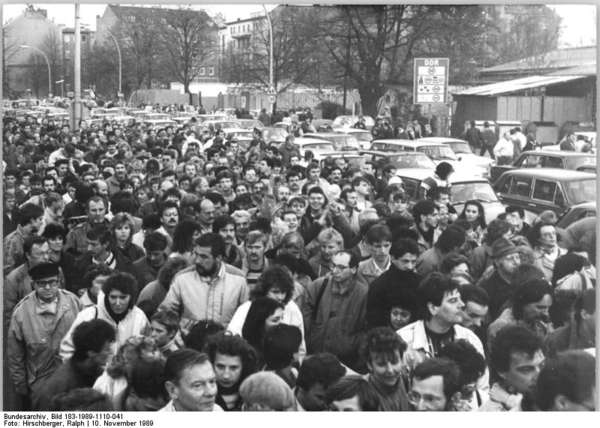30th anniversary of the fall of the Berlin Wall - Sources on the East German past
- 09. November 2019 - Anniversary, Archives, Societies, Museums, Genealogy, General, Germany, Historical Documents, Historical Events, History, Knowledge
09 November is a special day in German history. In the year 1989 this finally meant something positive. On this day, the government of the German Democratic Republic (GDR) announced a new and long-desired travel regulation. People now could directly leave the GDR in the direction of the Federal Republic of Germany (FRG). This caused the fall of the Berlin Wall and finally led to the German reunification. For most Germans this is a day they still remember and they know exactly what they were doing when they learned about the fall of the Berlin Wall. However, I was still a child in West Germany. According to my parents it was not a happy day for me - my children’s television program was cancelled due to a special broadcast.
For genealogy, the division of Germany plays quite some role, too. The foundation of two separate states and especially the construction of the Berlin Wall and the closing of the inner-German border tore families apart and led to very different living environments in East and West Germany. Until today this affects the German society. On the occasion of the anniversary of the fall of the Berlin Wall we are having a look at the historic events and also discuss sources that can be useful for researching ancestors and relatives in the former GDR.
The peaceful revolution
On the evening of 09 November 1989, Günter Schabowski (spokesman for the Central Committee of the Socialist Unity Party of Germany or East German Communist Party) announced the new travel regulations during a press conference. The whole press conference (in German) can be viewed at the website of the German Broadcasting Archive. His statement that the regulation came into effect “immediately” was misleading. In fact, people were supposed to still file an application in order to leave the country, but without preliminary conditions. Spontaneously crowds of people went to the borders, in Berlin and elsewhere within the GDR. They wanted to test the new regulation right there. The border guards did not know about the new regulation and were therefore not prepared for the masses of people. In the end, they opened the borders shortly before midnight. Today there are only small parts of the Berlin Wall that once surrounded West Berlin. The longest part of the Berlin wall that still shows its structure, can today be viewed at the Berlin Wall Memorial.
The fall of the Berlin Wall sealed the end of the cold war, but why did it happen? The discontent of the citizens of the GDR became bigger and bigger for quite some time before. While other countries of the Eastern bloc had already initiated reforms, the East German state remained inflexible. In the year 1989, various events contributed to an escalation. There were huge protests after the last elections on 07 May since they were obviously manipulated, like all the elections before. Also, the support of the regime for the suppression of the student rebellion at the Tiananmen Square in Beijing on 04 June contributed to the discontent. The extent of the protests and demonstrations increased and became more and more organized. From 04 September onwards, the famous Monday demonstrations started in Leipzig.
Besides the mass demonstrations the mass flight of the citizens of the GDR was a big problem for the regime. There were more and more applications for emigration and thousands of people tried to enforce their departure by occupying Western diplomatic representations in Budapest, Warsaw, East Berlin and Prague, partly successful. From 11 September onwards the border between Hungary and Austria could be crossed legally and thousands of people made use of it every day. Many also flew through Czechoslovakia.
In this climate, the 40th anniversary of the GDR was no help at all and the removal of Erich Honecker as Secretary-General of the Socialist Unity Party of Germany was not enough to stop the democratic movement.
The opening of the borders did not automatically mean a German reunification. In fact, it would have been quite possible that two separate states would coexist. However, the East German government had completely lost the trust of its people and still thousands of citizens departed to the West every day. Also, the economic situation was desolate and the state deep in debt. This led to the final collapse of the regime and just short of a year after the fall of the Berlin Wall to the German reunification on 03 October 1990.
Special sources for genealogy
For our clients, we are of course often researching in federal states that formerly belonged to the GDR. We observed that documents from the civil registration offices of the GDR often do not contain as much information as those of West Germany. Also, the preservation of resident registration cards is rarer. This can make the research more difficult.
Next to civil registration documents, church books and resident registration cards, there are of course other sources that can sometimes provide a lot of information on the living conditions of ancestors. The following information does not claim to be comprehensive.
Best known are probably the documents of the State Security Service/Ministry for State Security, or short Stasi. It is possible to apply for access at the Federal Commissioner for the Records of the State Security Service of the former German Democratic Republic. However, it is planned to hand over the documents to the federal archives in summer 2021.
The federal archives, at the moment mainly the departments in Berlin-Lichterfelde and Freiburg im Breisgau, already hold many other sources regarding the former GDR. Among them is for example a central register for prisoners that contains information on the penal institutions where the respective prisoner was kept. There are also various case and execution files as well as prisoner files. Further prisoner files and documents can be found at the Federal Commissioner for the Records of the State Security Service of the former GDR, at the responsible state archives or at today’s prisons.
Furthermore, the federal archives have documents of the National People’s Army as well as of various commissions, offices and institutions. The archive material of the Socialist Unity Party of Germany and various mass organizations like the Free German Youth (FDJ) are kept at the Foundation Archives of the Political Parties and Mass Organizations of the GDR (SAPMO) that is located at the federal archives. The state archives can have further information on those organizations.
The federal archives also have documents regarding the Jugendwerkhof Torgau. Further documents on other Jugendwerkhöfe (homes for the re-education of young people) can usually be found at the respective state archives of the German federal states.
In general, the state archives can have interesting further sources that were not mentioned before. Also, smaller district, community or city archives can have helpful information. And last but not least, there can be other archives, for example from the civil rights movements or from the various institutions for reappraisal that can have further interesting documents.
You can also find information, for example on forced adoptions in the former GDR at the German Red Cross Tracing Service.
And we should not forget newspapers. At the newspaper portal for GDR press (only in German) it is possible to do a full text search in three newspapers (Neues Deutschland, Berliner Zeitung, Neue Zeit).
If we can assist you with your genealogical research in East or West Germany or even someplace else, please feel free to contact us at any time.


0 comments